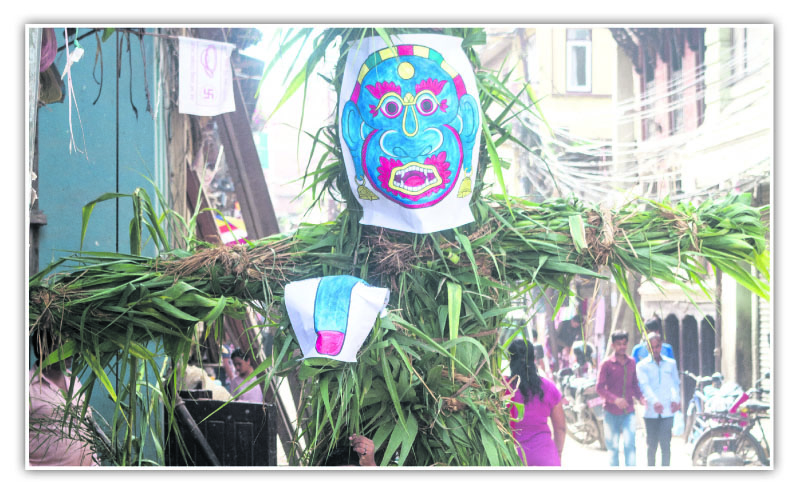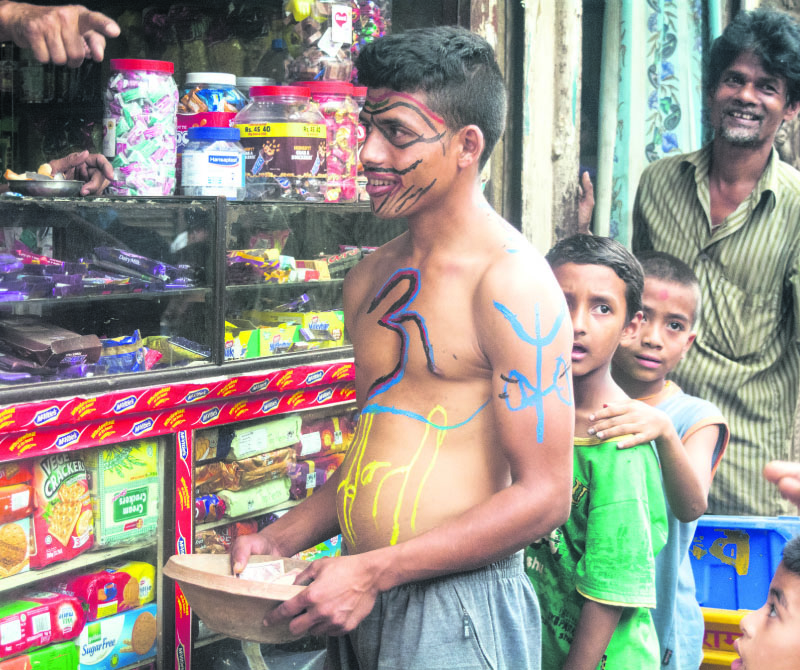Hari Bahadur Thapa’s ‘Rajgaj’ out in market
6 years ago

6 years ago

6 years ago

6 years ago

6 years ago

6 years ago

Around 10 elderly had gathered on the Dabali area of Naradevi temple, Naradevi to assemble fresh green reeds into groups of six. These assembles were then arranged in a human-like shape — two hands, three legs and a face — to create Ghantakarna (a mythical being, also believed to be the incarnation of Lord Bhairav) and Goddess Naradevi. What differentiated the two were the posters that were later added to the effigies: one with a picture of a penis to represent Ghantakarna while Naradevi had an eye-shaped poster to represent her genitals.
If explicit display of genitals was not enough to entice curiosity among non-Newar passersby, the elderly discussing the religious and historical significance of Gathemangal festival certainly were.
The Newar community celebrates Gathemangal every year on Shrawan Krishna Chaturdashi, and this year it was celebrated on Friday. Also called ‘Gaanthaamo’ or ‘Gathaanmo’, Newars celebrate the festival to protect themselves and get rid of demons and evil spirits. In Newari, ‘gaan’ means bell and ‘mo’ means head, which collectively refers to the demon of the festival - Ghantakarna.
One could observe a definite confusion among children in regards to pictures used in the effigies. Upon asked, there was only so much an eight-year-old girl could say about the effigies, except that going underneath them protected her from diseases.
There was a dramatic turn of events when a curious bunch decided to ask their parents about why Naradevi had just one eye. Instead of answering the question honestly, one of the parents decided to yell out loud to the creators of effigies, “Euta aankha chutecha (one eye is missing)”. This was a clear indication that Newars want to openly celebrate the festival, but are yet to be explicit to their children about why the festival is celebrated.
Apart from the effigies, people celebrated the festival by offering money, clothes, salt and handmade dolls to a semi-naked man, who for the occasion wore black tar on his face. Numerous shapes of sensual nature were drawn all over his body to make him a symbolic representation of Ghantakarna.
This man was supposed to sit near Ghatakarna’s effigy, except at times when he was roaming around the city to collect donations. When he walked, he periodically recited “Om Shanti Jay Nepal, Aaju Dyo Ha,” which in Newari language is a general appeal for peace and ancestors’ blessing. An enthusiastic bunch of children followed the man wherever he went.
On an individual level, Newars customarily clean their houses and celebrate the day by eating Samaybaji made of beaten rice, black soybean, garlic, ginger, meat and potatoes. Girls of the community are also seen wearing henna during the occasion. Children and the elderly alike are seen wearing iron rings and “hit iron nails into houses” to protect themselves and their houses from evil.
A call for collective effort is summoned later in the afternoon when people gather to create effigies from green reeds and hay straws, pull the effigies to Bishnumati River or any other water sources before burning them down.
While all of the aforementioned activities happen, Newars make significant donations in Ghantakarna’s name. Ramkrishna Maharjan, a spectator at Naradevi area, said “It is believed that if you offer donations to Ghantakarna, you won’t be disturbed by evil spirit or ghosts.”
According to priest Roshan Bajracharya, farmers had once taken help from Ghantakarna -- the helpful ghost -- to plant rice in their fields. The demon had bells hanging from his ears which later earned him the name of Ghantakarna. However, the demon soon started eating a lot and had to be chased away. Before chasing him away, however, villagers treated him to “dahi chiura” (curd and beaten rice) and collected clothes, money and food for him.
Few others associate Ghantakarna with Lord Bhairav. Given the similarities in their looks and name, Ghantakarna is taken as an incarnation of Lord Bhairav. Both are referred to as Aaju Dyo. Perhaps that is why an effigy of Naradevi (also called Aajima) is simultaneously built in the Dabali area.
At the end of the day, Ghantakarna and Naradevi are “supposed to unite”. “Ghantakarna will be put over Naradevi’s effigy and they will be immersed together into the Bishnumati River,” added Roshan Bajracharya, who serves as a priest in a local temple. Similar notion of the holy Sangam (intercourse) are common in the religious scriptures.


Leave A Comment